Education transforms lives. BRIDGE makes it happen.
UNESCO House, Seoul, Republic of Korea • 31 May - 2 June 2023






Sponsored by







2023
Workshop
Bridge
Final Report

1
Contents
Summaryof the 2023 Bridge WorkshopSessions
● Opening
● Workshop1: Overviewof theBridge Programme & Presentationof CaseStudiesfor PeerLearning
○ Overview of Bridge Programme
○ Non-formal Education Status System (Bhutan)
○ Community Learning Center (CLC) Management Manual (Laos)
○ Sharing of Best Practices
■ Jordan
■ Malawi
■ Pakistan

■ Sri Lanka
■ Timor-Leste
● Workshop2: How to Write ProjectConceptPapers(PCPs)
● Workshop3: Howto WriteBi-MonthlyReports usingGoogleApplications
● Workshop4: ConsultationSessionson Examinationof ProjectStatusandReview ofProjectConceptPapers
● Visitto theNationalInstituteforLifelongEducation
● PublicEvent:YouthTalksBRIDGE
○ Introduction of Republic of Korea’s Strategy for ODA in Education
○ Project analysis: From Korean Youth Perspectives
Summary of the Informal Meeting of National Commissions for UNESCO
InformalMeetingof NationalCommissionsforUNESCO ○ UNESCO National Commissions’ Brochure Project ○ Sharing of Civil Society-PrivateSector Partnership Annex ● Listof Participants ● MediaCoverage ● PresentationMaterialsandPhotos 5 7 18 20 22 25 28 41 53 55 63 2
●
Summary of the 2023 Bridge Workshop Sessions

3

4
Opening
The 2023 Bridge Workshop began with an opening speech by the Secretary-General of the Korean National Commission for UNESCO, Dr Kyung-Koo Han, followed by welcoming remarks from the Director-General of the Global Education Planning Bureau, Ministry of Education of Republic of Korea, Ms. Ji-young Park, and congratulatory remarks from two Members of the National Assembly, Mr DongYoung Seo and Mr Byungwook Kim
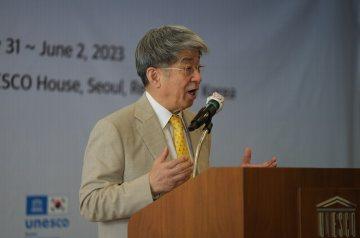
● Dr. Kyung-Koo Han, Secretary-General of the KNCU, emphasized the workshop's commitment to education, global partnerships, and addressing disparities to enhance collaboration and ongoing projects for a brighter future
● Ms. Ji-young Park, from the Global Education Planning Bureau of the Ministry of Education in the Republic of Korea, emphasized the Ministry's support for the Bridge Programme and the importance of inclusive and quality education in addressing challenges and expediting education for all.

● Mr. DongYoung Seo, Member of the National Assembly of the Republic of Korea, commended the Bridge Programme for advancing inclusive education, and stated his confidence in the Bridge Workshop's role in sharing SDG 4 best practices post-COVID-19

● Mr Byungwook Kim, Member of the National Assembly of the Republic of Korea, commended participants for their efforts in achieving inclusive education, recognizing the transformative power of education in fostering a prosperous world community

5
Photo session

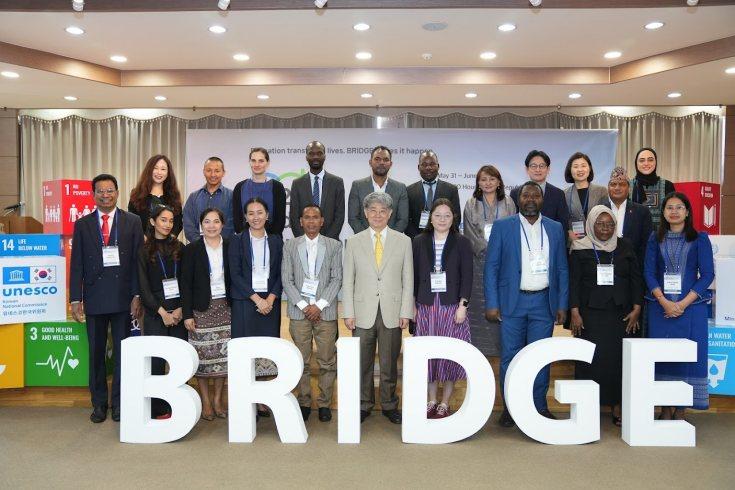
6
16Participantsfrom12countrieshavingaphotosession
WORKSHOP 1: Overview of the Bridge Programme and Presentation of Case Studies for Peer Learning
1 | Overview of the Bridge Programme
PresentationbyMs.SunKyungLee,Director&Ms.GraceKim,ProgrammeSpecialist, K
Summary of Presentation
● Ms. Sun Kyung Lee, Director of KNCU’s Division of the International Cooperation Programme, introduced the background, progress, and achievements of the Bridge Programme throughout the years, noting that the programme has positively impacted the lives of 140,000 learners and teachers in various ways, including through literacy education, vocational training, early childhood education, and climate change education. She discussed the crucial nature of the development and implementation of education policies pertaining to out-of-school education, emphasising the objective of improving the quality and accessibility of education particularly for marginalised groups.
 Ms.SunKyungLee,DirectoroftheDivisionofInternationalCooperationProgrammedelivering herpresentation
Ms.SunKyungLee,DirectoroftheDivisionofInternationalCooperationProgrammedelivering herpresentation
7
● She showed the importance of the Bridge Programme, providing examples of successes from past years’ Bridge Projects in Laos and Malawi She mentioned that one of the key factors for the success of the Bridge Programme is the strong partnerships at both local and international levels and the involvement of different organisations and groups that help make the programme effective, impactful, and feasible within each partner country She noted that the ongoing challenge is in the area of sustainability and feasibility and in this regard, Ms Lee suggested that KNCU and its partners in the programme should make focused efforts to enhance quality management and to expand the scale and capacity of the programme by increasing the number of country projects, which would also increase visibility of the programme
Ms GraceKim,ProgrammeSpecialistoftheDivisionofInternationalCooperationProgramme deliveringherpresentation
Summary of Presentation
● Ms. Grace Kim, a Programme Specialist in KNCU’s Division of the International Cooperation Programme, spoke about the indicators used to measure the impact and outcomes of the Bridge Programmes She briefly discussed the ODA cycle in the Republic of Korea, and why and how the programme’s qualitative and quantitative outcomes are helpful in securing ODA funds She noted the importance of providing proper data to relevant stakeholders as it promotes the visibility of the project at both international and national level She also offered examples of possible outreach and communication methods, including newsletters published by national commissions for UNESCO, international meetings, and press coverage
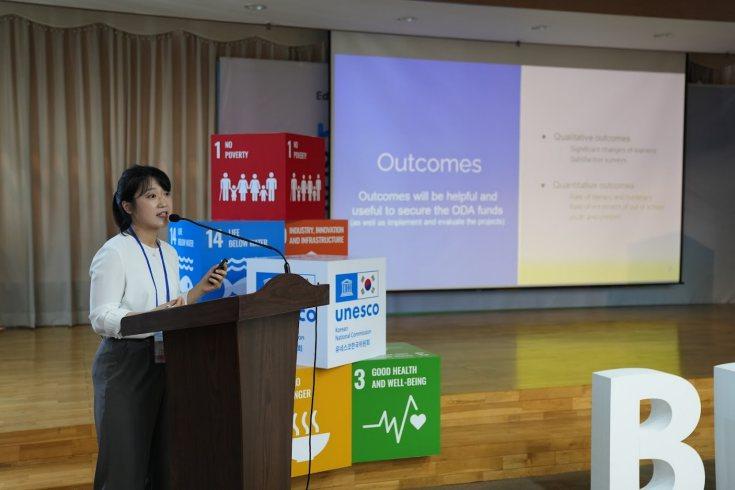
8
Q&A Session
● Q. Mr. Dochu, Chief Planning Officer at Bhutan’s Ministry of Education and Skills Development, pointed out the limitation of quantitative data analysis in relation to lifelong education projects He mentioned that in Bhutan, the simple increase of NFE (Non-Formal Education) centres is never the goal, but instead educating as many students as possible is more important and said that it was not helpful to claim that small schools are unsuccessful because their numbers are small in quantitative data, and that such data is not the best measure to understand educational progress
○ A. Ms. Grace Kim agreed with the commenter, but re-emphasised the importance of visible data as hard data is important in government projects She noted that KNCU’s goal is to be able to provide all children the education they want and need, but that sometimes demonstrable numbers and impacts are needed to sustain the project She mentioned that, since the programme has so many indicators, the best indicators for each country could be further discussed throughout the workshop

ParticipantattheQ&Asession 9
2
|
Development of a Non-Formal Education Management Information System
PresentationbyMs.RinzinWangmo,BhutanNationalCommissionforUNESCO
 Ms RinzinWangmodeliveringherpresentation
Ms RinzinWangmodeliveringherpresentation
Summary of Presentation
● Ms. Rinzin Wangmo, Chief Programme Officer at the Department of Education Programmes in Bhutan’s Ministry of Education & Skills Development, gave a presentation on best practices from the Bridge Bhutan Project and introduced some of the project’s areas of focus. She gave a brief introduction to the context in Bhutan and mentioned that the project’s main activities focus on the enhancement of adult literacy and skills development She mentioned that one current focus is the implementation of a Non-Formal Education Management Information System (MIS), with a concurrent emphasis on digital literacy. She said that the objective of the MIS is to create an integrated system that provides reliable and accessible data to all, considering the importance of data in the age of technology
10
● Ms.Rinzin Wangmo introduced the six modules in the NFE-MIS, the first of which focuses on centre management, while the second focuses on instructor registration, the third module concerns learners, including registration, cost of learning, attendance, dropouts, their future plans, and achievements, the fourth module is for monitoring and evaluation, overseeing the centres and involving local leaders, the fifth module is a repository for those involved in the programme and, the sixth module involves generating reports at different levels, such as district, student, and teacher level. She noted that, despite the challenges faced in 2020 and 2021 as a result of COVID-19, the system has been successfully developed and has become more stable
● Additionally, she briefly discussed two examples of best practice and success, including non-formal education in tailoring to promote women’s economic independence She also mentioned the case of an NFE and CLC graduate who successfully completed a vocational skills programme and now helps the CLC instructor to conduct baking classes and is planning to open her own bakery.
Summary of Presentation
● Ms. Phaly Phanlouvong, Technical Staff from the Department of Non-Formal Education at the Ministry of Education and Sports of Laos, presented on the best practices of the Bridge Project in Laos She first provided basic information on the project and how the project activities that have been implemented since 2020 have helped the sustainability of education
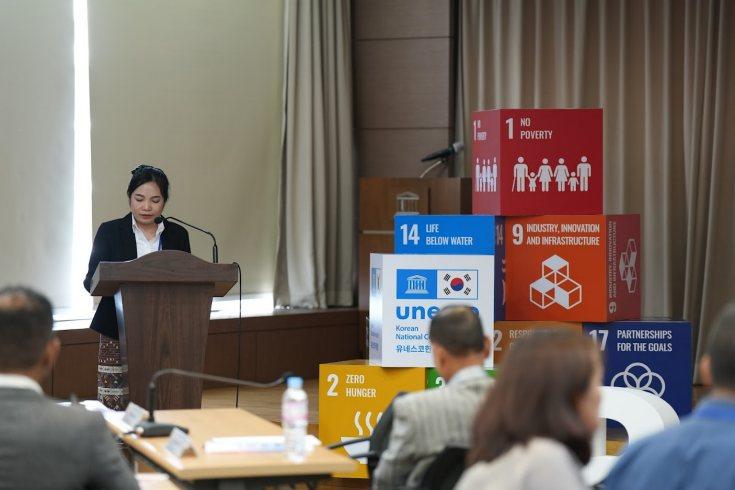
P M
3 | Comm nit Learning Center (CLC) Management Man al
11
● She presented some of the project’s achievements, including the provision of equipment for the project to CLCs and to the Department of Non-formal Education (DNFE), the Department of Provincial Education and Sports Services (PESS), the District Education and Sports Bureau (DESB). This equipment included computers, radios and speakers for CLCs, motorcycles for the DESB, textbooks, notebooks, pens, pencils, and cotton bags for teachers and students in equivalency programme classes, and equipment such as incubators and mushroom sterilising pots for basic vocational training at CLCs.
● As an example of one of the Bridge Laos Project’s successes, she described the process of developing a CLC manual She noted that the manual helped personnel involved in running the CLCs by providing information in six sections. These sections covered subjects including the duties and responsibilities of CLC personnel, CLC management (including both general and financial administration), CLC planning, and overarching principles
Q&A Session
● Q. Dr. Jihon Kim, Chief of Division of International Cooperation Programme at KNCU, asked if there were any other countries that had a similar system for CLC management
○ A. Mr. Chifuniro Clement Chikoti, Interim Bridge Project Manager at Malawi National Commission for UNESCO, responded they do not have a manual, but do have a constitution document in which the roles of the members and various positions are defined, thus giving some structure, though they look forward to improving it
○ A. Mr. Francisco Barreto, Executive Secretary at Timor-Leste National Commission for UNESCO (TLNCU), responded by talking about the structure of the project in Timor-Leste, which focuses on literacy, life skills, and an additional programme He mentioned that the project has been ongoing since 2013 and involves collaboration with government ministries and community leaders. He noted that the role of the government ministries and TLNCU is to provide advisory and technical assistance, while students have the responsibility of actively participating in the programs He noted that the project aims to provide opportunities for continuous learning.
○ A. Ms Sengpapha Holanouphab, from the Lao National Commission for UNESCO responded by talking about how the success of their programme is attributed to the collaboration between provinces, districts, and villages. She said that committees at various levels work together, directly engaging with and motivating people to recognize the significance of education She also noted that this cooperation within the programme has resulted in increased participation of children in the equivalency programme
12
4 | Sharing of Best Practices
PresentedbytherepresentativesfromJordan,Malawi,Pakistan,SriLanka,andTimor-Leste
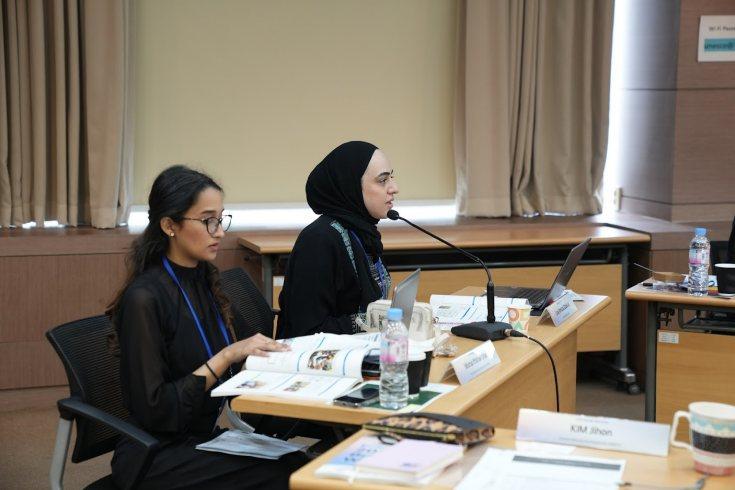 Ms LinaAlmutazQtaishatpresentingbestpracticesfromtheBridgeSejongJordanProject
Ms LinaAlmutazQtaishatpresentingbestpracticesfromtheBridgeSejongJordanProject
● Ms. Lina Almutaz Qtaishat, Project Manager at Taghyeer in Jordan, presented on the best practices from the “We Love Reading" programme, which focuses on promoting reading among children in their mother tongue, with the aim of improving children’s cognitive skills She talked about how parents are trained on how to read for children, and how they have control over various aspects of the programme, such as choosing the location She noted that the programme, supported by KNCU, has conducted six trainings for over 150 parents and distributed 150 book packages containing more than 25 books, and that more than 1,800 reading sessions have been conducted as part of the programme She also mentioned that partnerships have been formed with community-based organisations, universities, and the government, and these partnerships helped build trust with women in the community and involved specialists for research purposes. In terms of evaluation, she mentioned that the participants were divided into control and reading programme groups, and data were collected at two different time points for comparison analysis In the final step, research findings were not only shared with academic stakeholders but also discussed with all programme ambassadors.
S
13
● Mr. Chifuniro Clement Chikoti, Interim Bridge Project Manager at the Malawi National Commission for UNESCO, explained that the Bridge Malawi Project has two tracks, Community Learning Centers (CLC) and policy systems, both aligned with SDG 4, and aiming to provide accessible education opportunities to marginalised communities. He noted that the project’s best practices include afterschool programmes and adult literacy initiatives, with programmes for children focusing on children around age six for formal education readiness, and after school programmes for standard 1-8, and adult programmes encouraging participation from individuals aged 15 and above. Over 150 children and 100 adults have been reached. The presenter added that functional literacy is promoted up to education level 8, covering subjects like life skills and mathematics, and that training is provided for CLC teachers and community members. In terms of project expansion, he noted that CLCs are being established in a northern district, and that promotional materials such as notebooks, T-shirts, and bags are being used to enhance project visibility
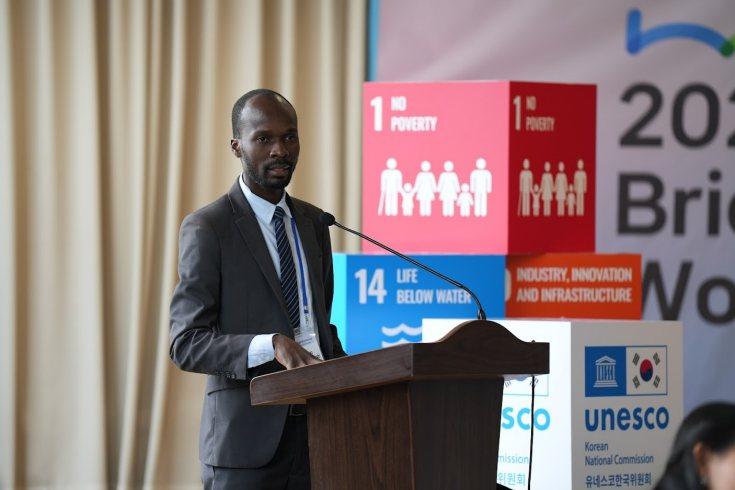 Mr ChifuniroClementChikotipresentingbestpracticesfromtheBridgeMalawiProject
Mr ChifuniroClementChikotipresentingbestpracticesfromtheBridgeMalawiProject
14
Ms MishalIftikharShafipresentingbestpracticesfromtheBridgeSejongPakistanProject
● Ms. Mishal Iftikhar Shafi, Proposal and Documentation Facilitator at Bunyad Literacy and Community Council, shared best practices from the Bridge Pakistan Project, which focuses on promoting women's lifelong education to combat high illiteracy rates among females She noted that the project provides education beyond basic literacy, offering practical knowledge applicable to real life and that over a hundred thousand people have benefited from their programmes, which primarily take place within women's homes to address restrictions on female mobility She added that CLCs and homes serve as platforms for empowering women, equipping them with skills for earning a living and improving their lives. She also mentioned that the project provided computer education to improve technical skills in rural areas and that efforts were made to raise awareness about women’s health to improve daily life for rural women. She also mentioned activities to make use of mobile phones to support women’s literacy learning through text messages and e-books, covering topics such as entrepreneurship, to ensure that women did not forget what they learned The presenter mentioned that budgeting lessons were offered to improve financial awareness, as well as education for women on their rights in cases of abuse or divorce, and that the initiatives of the project have resulted in improved quality of life for women Additionally, she mentioned that a mobile library distributes books to children, promoting literacy among the younger generation.

15
Mr RasikaBalasuriyapresentingbestpracticesfromtheBridgeSejongSriLankaProject
● Mr. Rasika Balasuriya, Senior Lecturer at the National Institute of Education in Sri Lanka, said that the Bridge Sri Lanka Project focuses on providing both formal and informal education opportunities to meet the diverse needs of individuals who were unable to complete their education due to various factors The presenter mentioned that the project operates in 20 regional centres, which have been offering open schooling programmes since 2007 and which cater to diverse needs, including mental health and hospital settings He said that the Bridge Sri Lanka Project prioritises basic literacy education, starting with teaching students how to write their names and progressing to numeracy skills. He added that supplementary courses are available for secondary learners and the duration of the programme varies based on individual progress and exam results He mentioned that evaluation processes are conducted annually, with questionnaires sent to a random sampling of students and the collected data are analysed using computer software to identify any issues and plan for future improvements The presenter said that the project serves marginalised communities, including multicultural communities where flexibility is provided to address different religious requirements.

16
Mr FranciscoBarretopresentingbestpracticesfromtheBridgeTimor-LesteProject
● Mr. Francisco Barreto, Executive Secretary of the Timor-Leste National Commission for UNESCO, spoke about the literacy and life skills being spread through CLCs under the Bridge Timor-Leste Project Currently, he noted, there are 10 CLCs, and the project’s 5-year plan is to build a total of 16 He said that, due to budget limitations, it is not possible to have a CLC in every district, but the support from the Bridge Programme has helped increase the number of CLCs to align with the national plan, and that the locations for establishing CLCs are chosen based on the number of illiterate people in the local population He mentioned that teacher training is conducted for the project’s literacy education programme, with 63 teachers receiving training in 9 CLCs and municipalities/districts, through a collaboration with the Ministry of Education He said that the literacy teaching process is observed by the Ministry of Education, involving both the Minister of Basic Education and the Minister of Higher Education He noted that the programme has over 200 students currently enrolled, and in some years, up to 500 students participate He concluded by noting the success of the literacy programme

17
WORKSHOP 2: How to Write Project Concept Papers (PCPs)
Lecture | How to write Project Concept Papers (PCPs)
PresentedbyProf.JihyangLee,AdjunctProfessor,DepartmentofGlobalGovernance, KyungHeeUniversity

Summary of Presentation
● Professor Jihyang Lee, an Adjunct Professor from Kyung Hee University, gave a lecture on how to write a project concept paper (PCP) She began by setting the context in which a PCP is written, including what an education project is, what indicators are, and why they are important. The presentation explored the concept of an education project, emphasising the importance of fundamental rights, enabling rights, and the learner-centred approach Prof Lee discussed the need to consider the learners' needs, the transformative impact of education, and the focus on lifelong learning. She highlighted the importance of equity in education, stressing the importance of addressing the specific needs of vulnerable groups
Prof.JihyangLeedeliveringherlectureonhowtowritePCPs
18
● She further stressed the need to clearly identify the reasons for focusing on these groups in the project and to ensure that the project is evidence-based and has a positive impact on learners' lives She introduced the concept of project cycle management (PCM), noting its importance as a tool for setting objectives, managing budgets, and ensuring a logical and effective implementation of the project She mentioned the logical framework as one approach to structuring project activities, outputs, outcomes, and goals, although alternative frameworks are also used by some.
● Prof Lee continued by providing exercises for the participants to practise PCP writing The first exercise was focused on deciding what outcomes a particular project should seek to achieve and what activities can be used to achieve these outcomes. After the exercise she commented that when designing a project, establishing clear priorities and focus areas is crucial She gave some detailed comments for the example in the exercise and then emphasised that it is important to differentiate between outputs and outcomes.
● She provided two additional exercises and the participants continued to work in groups to solve them After both exercises, Prof Lee commented that it is essential to have different indicators for output and outcomes Using the same indicator for both does not make sense and output indicators should be countable and measurable, representing what was planned in project activities On the other hand, she noted that the purpose of measuring outcomes is to observe and assess the change that occurred, which can be demonstrated through outputs. She said it is crucial to be clear about the target of the project and how the desired change will be measured She concluded by saying that goals and targets should be decided based on evidence, and any increase in outcomes should be justified with a rationale



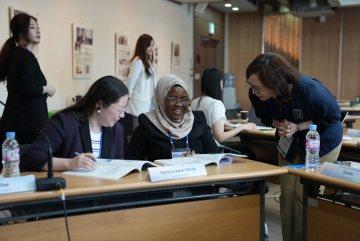
Participantsattheworkshop2session 19
WORKSHOP 3: How to Write Bi-Monthly Reports Using Google Applications
Lecture | How to Write Bi-Monthly Reports Using Google Applications
ByMs.GraceKim&Ms.DaheeSon,ProgrammeSpecialists,KoreanNationalCommissionfor UNESCO
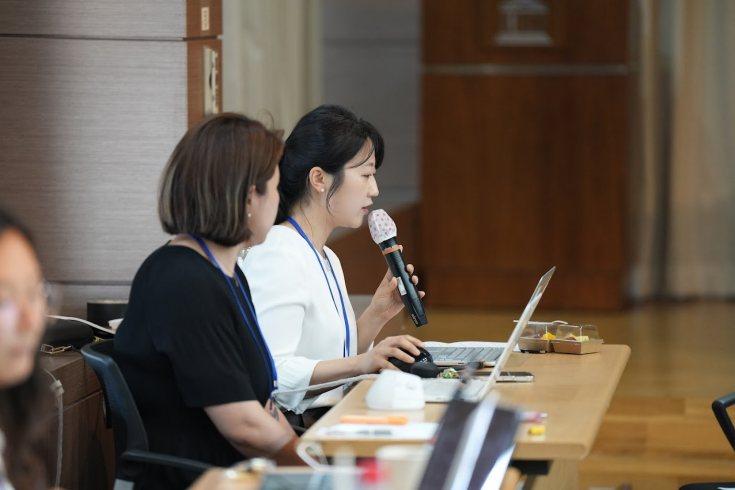
Ms GraceKimandMs DaheeSondeliveringherlectureonhowtowritebi-monthlyreportsusing Googleapplications
Summary of Presentation
● Ms. Grace Kim, a Programme Specialist at KNCU, gave a lecture on how to write bi-monthly reports for the Bridge Programme using Google applications She noted that Google Docs that had been shared with participants included the details of what information is necessary on the reports, thus the lecture was focused on the technical aspects of using Google applications.
20
● The objectives of bi-monthly reports were briefly mentioned: To track and manage the implementation of the projects, to provide reliable information regarding projects to related stakeholders and to assist with project monitoring and evaluation

● Ms. Kim provided the participants with instructions on adding links to documents and entering data for the total budget, expenditure, and balance She also explained how to write the activity progress reports, how to use the dropdown function, add comments and tag another person, and how to add photos to the Google document files.
● Ms. Dahee Son, a Programme Specialist at KNCU, continued the lecture by talking about how to write financial reports She began with the objective of financial reporting, noting the importance of using the same spreadsheet every time so that both KNCU and the partner organisation can see the accumulation of project actions, assess how much additional time a partner organisation needs, if there is leftover money that is yet to be spent, and be up to date on the entire project process
● She explained the technical aspects of the financial sheet, including how the name and number of titles of activities must remain the same throughout the project Ms Son continued by explaining how to process merging cells and clean up messy columns, how to use the analytics, and emphasizing that numbers must not be deleted. She noted that no calculations are separately needed as the sheet does these automatically She also noted that the financial progress shows all expenses and that in the third tab of the Google Sheet, the progress is shown automatically as a percentage. She emphasised that this number should also be put in the bi-monthly report
Q&A Session
● Q. A participant asked if the financial reporting should be in local currency or US dollars (USD)
P 21
WORKSHOP 4: Consultation Sessions on Examination of Project Status and Review of Project Concept Papers(PCP)



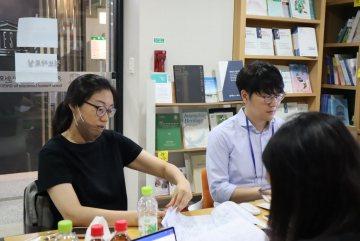
The consultation sessions focused on reviewing the status of current Bridge Projects (in Bhutan, Jordan, Laos, Malawi, Pakistan, Sri Lanka, and Timor-Leste) and making necessary adjustments to the planned schedules Simultaneously, candidate countries for the Bridge Programme (Cambodia, Ghana, Mongolia, Nepal, Rwanda, and Tanzania) discussed their Project Concept Papers (PCP) with experts, while also engaging in discussions regarding partnership opportunities and future collaboration. A representative from Rwanda remotely joined the sessions to engage in discussions concerning the PCP and explore potential avenues for collaboration and partnership
● Candidate countries for the Bridge Programme (Cambodia, Ghana, Mongolia, Nepal, Rwanda, and Tanzania)
22
Participantsattheconsultationsessions(Cambodia,Ghana,MongoliaandNepal)
Participantsattheconsultationsessions

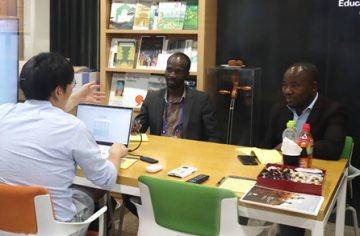
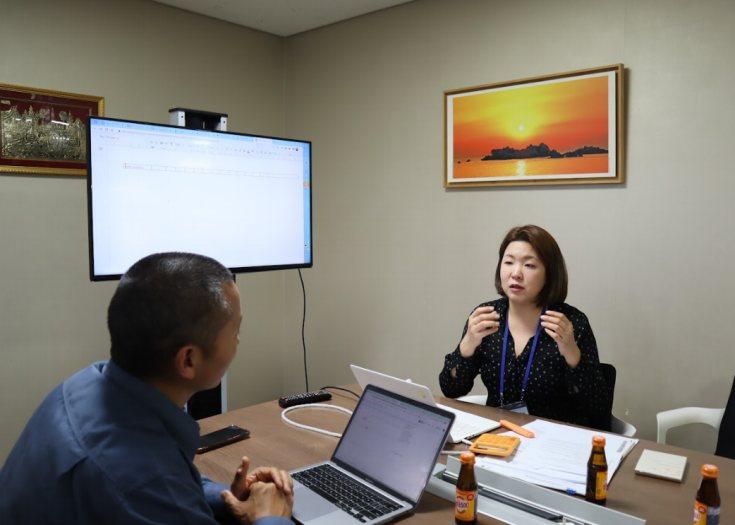


P
23
● Bridge Sejong Programme (Jordan, Jordan Pakistan and Sri Lanka)



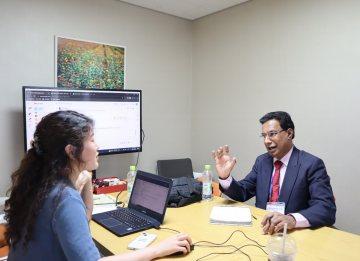


24
Participantsattheconsultationsessions
Visit to the National Institute for Lifelong Learning
WarmwelcomefromtheNationalInstituteforLifelongEducation

1 | Introduction to the National Institute for Lifelong Education (NILE)
PresentedbyMs EunjuLee,Director,OfficeofPublicRelations&InternationalAffairsatNILE
● Ms Eunju Lee, Director of PR and International Affairs at the National Institute for Lifelong Education of the Republic of Korea (NILE), gave an introduction to NILE. She began by explaining the legal framework relating to NILE, saying that they worked closely with the Ministry of Education to develop plans for lifelong education and conduct related projects. She mentioned that NILE carries out various functions through its 17 projects and actively engages in global networking, collaborating with organisations worldwide and hosting conferences
● She also provided an overview of the policy schemes and projects that have been conducted over the course of NILE’s history. She mentioned that lifelong education is being conducted at the national, metropolitan and local levels, but that NILE works at the national level, affiliated with the Ministry of Education, and focuses on expanding participation in lifelong education, supporting the digital transformation, resetting the lifelong education framework, and strengthening social values.
R e fo ex
25
● She then gave some examples of projects and initiatives undertaken by NILE, including the Academic Credit Bank System (ACBS), which recognises diverse learning experiences and converts them into degrees Other examples she gave were the Bachelor's Degree Exam for Self-Education System (BDES), which allows learners to obtain a degree through examinations, and the Lifelong Learning Account System, which provides learners with a portfolio of their learning history She noted that the institute also offers a Lifelong Learning Educator License programme Further examples included online classes called "Always Learning", the Match-Up programme, which allows students to obtain a short-term job competency qualification, and community-based lifelong learning initiatives The Lifelong Education Voucher programme, which supports lower-income adults with vouchers for lifelong learning courses, was also mentioned
Q&A Session
● Q. How do people train for skills in programmes like “Match-Up” and how are the programmes designed?
○ A. The Ministry of Education and NILE collaborated with the business sector to determine the specific areas and industries in need of development and through consultations, they identified the areas in which programmes would be developed


● Q. Are the participants already in the undergraduate programme?
○ A. The programme is not exclusively focused on a particular group and has a diverse range of individuals, including those who are already working and looking to reskill or upskill in their 40s or 50s, as well as recent graduates or individuals seeking new job opportunities In other words, the programmes are often open to participants regardless of their undergraduate status.
● Q. Do the companies give financial support to the students in some programs?
○ A. Funding is done by the government to the company
ParticipantsatNationalInstituteforLifelongEducationofRepublicofKorea
26
● Q. Where are the courses offered?
○ A. It’s hybrid in a lot of cases, but it depends on whether the course needs a classroom in order to conduct experiments or other in-person activities
● Q. What is the contribution of the company? Do they hire the people getting the education directly?
○ A. There is no automatic transition from the programme to getting hired but the participants may get benefits during the process. Mostly it’s that the government gives the private sector money to train individuals on the skills they need

● Q. What kind of illiteracy was the presenter referring to when she mentioned a 4 5% illiterate population?
○ A. The 4.5% is those in stage 1, who cannot read or write. Most of these people are in their 70 or 80s and didn’t have a chance to receive regular education in life
● Q. Who provides the certifications after finishing a programme?
○ A. It depends on the programme but most of them are provided by the government
● Q. Who provides the Lifelong Education Vouchers?
○ A. The Lifelong Education Vouchers are provided at NILE. NILE is in charge of the process and manages the organisations under the scheme
27
Public Event: Youth Talks BRIDGE
Youth Talks BRIDGE was a public event organised as part of the Bridge Workshop It included a presentation introducing the Republic of Korea's Strategy for ODA in Education, student presentations on the Bridge Programme, and engaging discussions The event began with an opening speech from Mr. Kwi Bae Kim, Assistant Secretary-General at KNCU, who emphasized the significance of every individual's opinions, perspectives, and experiences, recognizing their value in shaping our shared future and addressing global challenges. The event attracted about 100 attendees, consisting of both online and offline participants, including students specializing in international development and professionals in related fields


M t P 28
1 | Introduction of the Republic of Korea’s Strategy for ODA in Education
PresentedbyMr.KihyungKim,GlobalEducationPolicyDivision,MinistryofEducation
● Mr. Kihyung Kim, provided an overview of the Ministry of Education's initiatives both within the Republic of Korea and overseas He mentioned that South Korea’s President is committed to expanding educational initiatives and highlighted the nation's accomplishments in various sectors In terms of issues within South Korea the speaker identified three social issues in the Republic of Korea: demographic aging, the digital transformation, and regional decline To address these issues, he said, the ministry's reforms focused on strengthening national public education and care, promoting innovation in digital education, and transforming universities into driving forces for local communities. He noted that the ministry allocated a significant budget for ODA in the education sector, providing assistance to the specific needs of partner countries In terms of overseas support, Mr Kim outlined the Global Korea Scholarship programme, e-learning support, and the Global Educational Support programme, which cover higher education, vocational education, and basic education He highlighted the UNESCO BEAR Project, which shares South Korea's policy experience in human resources development He emphasised the importance of capacity building and empowering beneficiary countries for ongoing vocational education Additionally, he cited examples of positive outcomes in Malawi, Kenya, and Ghana Finally, Mr Kim expressed gratitude to the audience and encouraged students' interest in international development.

M
29
2 | Introduction to the Bridge Programme
PresentedbyDr JihonKim,ChiefofDivisionofInternationalCooperationProgramme,KNCU
Dr. Jihon Kim, Chief of Division of International Cooperation Programme at KNCU, gave a presentation introducing the Bridge Programme. She highlighted the programme’s focus on promoting equal access to education and universal literacy, particularly citing vulnerable populations affected by the COVID-19 pandemic She explained that the programme was launched in 2010, and collaborated with a total of 24 countries since then, providing diverse educational opportunities and benefiting over 1,000 learners and teachers. She further outlined the programme’s overarching framework, aimed at enhancing education quality and accessibility through activities such as policy development and the provision of educational supplies Dr Kim noted that the programme currently operates in eight countries, and that despite its notable achievements, it still faces challenges related to sustainability and feasibility She emphasized KNCU’s continuing dedication to address such challenges by strengthening the programme’s quality management and expanding programme capacity
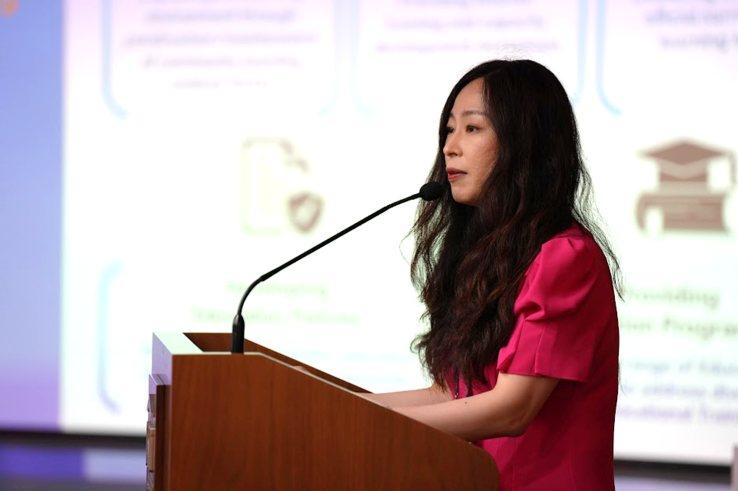
D presentation
30
P y of B g g p p g y g Project in one of the Bridge Programme’s partner countries and gave a presentation on the challenges facing the relevant Bridge country project and possible solutions to those challenges.
TheTeamMalawiconsistingofthreestudents (SuHyeonKim,HyeonKyeongKo,andSegura BilekeraVicente)presentingtheirprojectonthe BridgeMalawiProject


TheTeamBhutanconsistingofthreestudents (HyungwooKang,ChaeyeonJo,andSuhong Min)presentingtheirprojectontheBridge BhutanProject
● Team Malawi provided three ideas for the Bridge Malawi Project: 1) Introduce a system for selling or lending materials used in local learning centres to encourage voluntary learning through CDs or radios, 2). Produce promotional videos for the project, 3). Conduct a local survey on educational issues in Malawi and hold public contests, exhibitions, and forums to increase interest in UNESCO projects together with important cooperating countries

3 M
31
● Team Bhutan provided the following four ideas for the Bridge Bhutan Project: 1). Conduct the programme in people's homes in addition to CLC Centers, 2) Train adult learners as teachers in the centres and establish secondary education opportunities in villages, 3). Organize community cultural events, such as athletic competitions, and 4) Provide vocational experience programmes
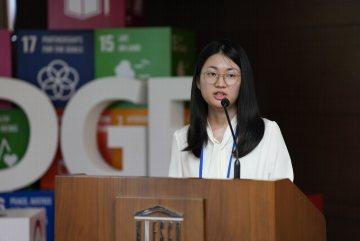
TheTimor-Lesteteamconsistingofthree students(JiwonJeon,DaeunHong,and ByeongheeKim)presentingtheirprojectonthe BridgeTimor-LesteProject

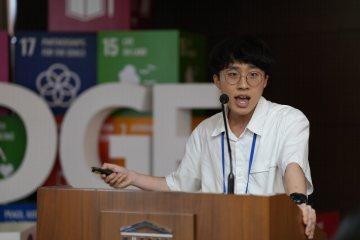
● Team Laos provided the following four ideas for the Bridge Laos Project: 1) Introduce celebrity ambassadors to promote the project within Laos, 2). Utilise videos and social media content, 3) Create a promotional song, and 4) Share knowledge with students and communities
● Team Timor-Leste provided the following three ideas for the Bridge Timor-Leste Project: 1) Providing various programme operations and education in progression, 2) Increasing community participation, and 3) Increasing budget utilisation
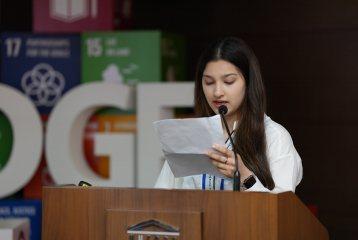 TheLaosteamconsistingofthreestudents (NanshanswutKim,JiyunKim,andHansol Park)presentingtheirprojectontheBridgeLaos Project
TheJordanteamconsistingofthreestudents (SoyoonEom,YoonaKim,andSoohyeonLee) presentingtheirprojectontheBridgeSejong JordanProject
TheLaosteamconsistingofthreestudents (NanshanswutKim,JiyunKim,andHansol Park)presentingtheirprojectontheBridgeLaos Project
TheJordanteamconsistingofthreestudents (SoyoonEom,YoonaKim,andSoohyeonLee) presentingtheirprojectontheBridgeSejong JordanProject
32
ThePakistanteamconsistingofthreestudents (YoungbinKim,DinoraTuraeva,andSeohee Hwang)presentingtheirprojectontheBridge SejongPakistanProject
● Team Jordan provided the following four ideas for the Bridge Jordan Project: 1). Providing puppet shows to help read and understand written stories, 2) Linking with schools, 3) Making Braille books, and 4) Making audiobooks by recording the voices of children who participate in the WLR programme. They added a suggestion for outreach to the public by distributing the products in various ways, including via YouTube
● Team Pakistan provided the following five ideas for the Bridge Pakistan Project: 1). Establishing clubs to strengthen the connections among programme participants 2)


d P T p 33
● Team Sri Lanka provided the following four ideas for the Bridge Sri Lanka Project: 1). Strengthening educational infrastructure, 2) Increasing educational personnel, 3) Providing a larger spectrum of education to vulnerable groups, and 4) Actively promoting the programme via media exposure.
After the presentations from all the youth teams, country representatives provided them with comments
● Mr. Apollonius Osei-Akoto Asar, Chief Programme Officer at the Ghana Commission for UNESCO, began by thanking the teams for a great presentation and pointed out that the economic side is not the only or most important variable in decision-making and that the macro and environmental perspectives should be considered and discussed as well
● Ms. Rinzin Wangmo, Chief Programme Officer at the Ministry of Education and Skills Development of Bhutan, commented that they hope to be able to conduct projects similar to those the Bhutan team mentioned and that their points were relevant, thus they would consider implementing them in CLCs
● Ms. Phaly Phanlouvong, Technical Staff from the Department of Non-Formal Education, Ministry of Education and Sports of Laos, commented that the presenters of Team Laos could talk more about the background of each project mentioned and that some activities were from projects that are already being led in Laos
● Ms Mishal Iftikhar Shafi, Proposal and Documentation Facilitator at Bunyad Literacy and Community Council, expressed some difficulties in implementing some of the suggestions as Pakistan does not have sufficient technology to fulfil them, but said that the recommendations were really good, and she hoped to be able to get there in the end.
● Ms. Lina Almutaz Qtaishat, Project Manager at Taghyeer, said she had enjoyed the team’s deep understanding of the essence of their programme, also making good use of terms. However, she mentioned that she did not agree with the puppet show advice as one of their biggest successes is the simplicity of the programme She added, however, that audiobooks are a very good idea as children would be able to continue reading even when the parents are not present
34
Participantsprovidingfeedbacktothepresentations

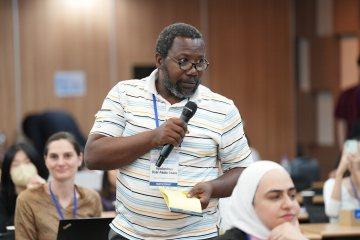
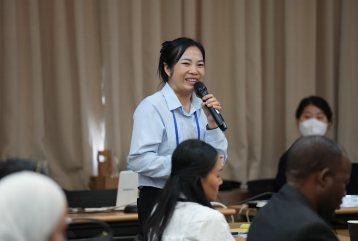
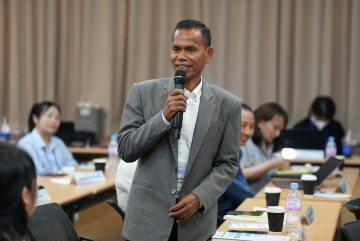


35
| 4 Discussion
LedbyProf JihyangLee SeoulNationalUniversity
● Professor Jihyang Lee, began the discussion by complimenting the students on their efforts and then brought up the question, “How can we involve youths in the Bridge Programme?”

● Mr. Chifuniro Clement Chikoti, Interim Bridge Project Manager at the Malawi National Commission for UNESCO, began by commenting that going digital is an easy way to engage youth in the programme and to facilitate interactions with them. He added that this would also allow participants to be able to engage more and join the teaching process as well
● Ms. Urangaa Erdenee, Programme Specialist for Education at the Mongolian National Commission for UNESCO, continued by stating the importance of involving youth in such projects as they really contribute a lot to them She added that one of Mongolia’s projects involved youth as researchers and that they were all really keen on working, volunteering, and learning Incorporating social networks is important too, she added
● Ms. Mishal Iftikhar Shafi, Proposal and Documentation Facilitator at Bunyad Literacy and Community Council, mentioned Bunyad’s active usage of social media As Pakistan has a very young population, she agreed that getting celebrities into the programme could help youth join them even more in their activities.
P
36
● An audience member from the Republic of Korea commented that culture can be a way to increase cooperation with youth and that youth these days already realise the importance of global cooperation


● Another audience member from the Republic of Korea commented that it is necessary to create a learning society and to use the local community resources, like local bookstores which are often used as an educational place, and that youth can gather there and share their opinions.
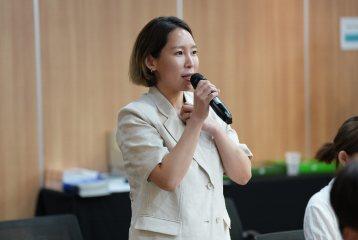

37
Participantsatthediscussionsession

P 38
Photo session
Summary of the Informal Meeting of National Commissions for UNESCO

39

40
Informal Meeting of National Commissions for UNESCO

Opening
Participants:Representativesfrom11NationalCommissionsforUNESCO (Bhutan,Cambodia,Germany,Ghana,Laos,Malawi,Mongolia,Nepal,RepublicofKorea, Tanzania,Timor-Leste)
Programme, briefly explained the topic and purpose of the informal meeting. She emphasized that, given the difficulty of gathering representatives from so many national commissions together in person, this was a valuable opportunity to discuss and share information, and that the meeting would focus particularly on partnerships with civil society and the private sector
● Dr. Kyung-Koo Han, Secretary-General of the KNCU, also joined to make introductory remarks He explained that he considered the meeting to be highly significant due to the unique nature of national commissions, which sets them apart from other institutions After sharing some of his personal experience, he acknowledged the role of national commissions in facilitating cooperation efforts and expressed hopes for a productive session to better understand one another.
P y g , p
41
Participantsatthe2023InformalMeetingofNationalCommissions
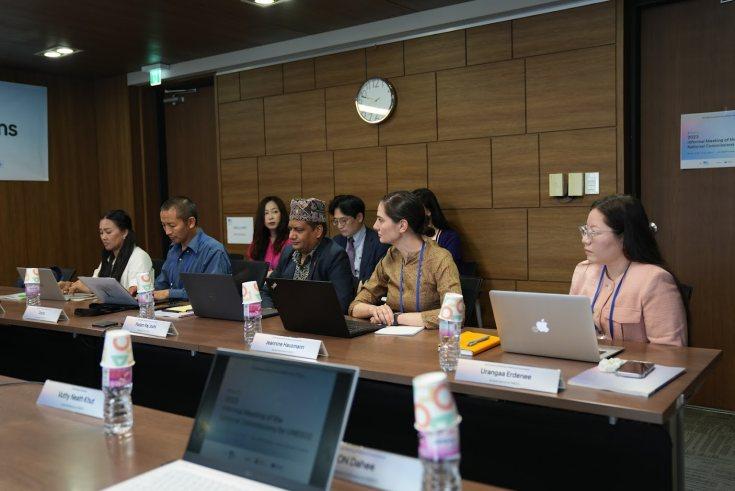
● Ms Dahee Son from KNCU introduced the brochure series, initiated by the DUK and the French National Commission with the aim of providing accessible information and fostering exchanges of ideas among national commissions for UNESCO(Natcoms) Ms Son focused on the upcoming publication of a brochure that KNCU is currently planning to produce to explore the issue of building and maintaining partnerships between UNESCO national commissions and civil society and the private sector. She mentioned the acknowledged growing demand for systematic processes for cooperation with these partners and referenced the "UNESCO Comprehensive Partnership Strategy'' aligning priorities with civil society concerns. She noted that KNCU plans to identify partners such as NGOs, local communities, youth groups, private corporations, academia, and other experts and that the brochure will examine the benefits, limitations, and working processes involved in establishing such partnerships. She explained that by the end of the year, a solid plan and concept paper will be developed and in 2024, research and consultation, including online surveys, will gather examples of best practices from national commissions, and that the final version of the brochure will be published in both French and English
● Ms. Jeannine Hausmann elaborated on the reasons behind the project, discussing the purpose and development of the brochure series and emphasising the need to showcase best practices to inspire cooperation among national commissions Giving the example of a brochure series that the German Commission produced with the French NatCom in 2019, she explained that the objective was to strengthen universal and inclusive multiculturalism, as stated in UNESCO's constitution
P P &
42
● She noted that the brochures covered various topics, including legal bases for partnerships; objectives; benefits; requirements; constraints; the role of headquarters and field offices, regional networks, sub-regional networks; forms of bilateral cooperation; and profiles of national commissions active in this area. Ms. Hausmann discussed consulting with all national commissions to gather additional examples and perspectives She also expressed gratitude for any contributions from the audience and said that they hoped to receive feedback from UNESCO soon and aimed to publish the brochures, including translations, by the end of the year.
Bhutan | Examples of Partnerships with Civil Society and the Private Sector
PresentedbyMr Dochu,MinistryofEducationandSkillsDevelopment,Bhutan
● Mr. Dochu presented some examples of Bhutan NatCom’s partnerships with civil society and the private sector He began by giving basic information on the country and on the Bhutan National Commission, and an overview of civil society organisations in Bhutan He noted that the Bhutan National Commission has four key strategies in developing its partnerships with civil society organisations (CSOs): 1) Having the head of the CSO as an Executive Committee member, 2) Joint projects, 3). Resource mobilisation, and 4). Sharing knowledge and expertise.
● Mr Dochu continued his presentation by discussing successful partnership examples He gave an overview of the partnership with RENEW, a non-profit organisation, which focused on baking and weaving non-formal education. He also mentioned a partnership with the Women in Stem Group, which involved holding STEM festivals and encouraging girls and women to continue higher education in STEM subjects Additionally, he highlighted efforts to establish connections with government ministries and provide external support while connecting with other agencies.
● He concluded the presentation by mentioning some challenges and suggestions for overcoming them The challenges consisted of three factors: 1) different goals and objectives between CSOs, private sector organisations, and the National Commission; 2) limited resources and unequal power dynamics within a partnership; and 3) trust issues that may occur when different values or operating principles are imposed To solve these issues, he suggested defining shared goals, addressing power and resource imbalances, building trust, and agreeing on decision-making processes
43
Cambodia | Examples of Partnerships with Civil Society and the Private Sector
PresentedbyMs.VuthyNeathKhut,CambodianNationalCommissionforUNESCO(CNCU)
● Ms. Vuthy Neath Khut presented some examples of the Cambodian NatComs partnerships with civil society and the private sector She explained that the CNCU’s policies for cooperation between government ministries and civil society prioritise transparency, inclusivity and sustainability Key strategies for partnership that she mentioned included building relationships, identifying common goals, facilitating communication, and providing support
● She provided three examples of civil society and private sector partnership, the first one being in Takeo Province, where the focus was on strengthening the economic role of women and their social inclusion in the region She said that the CNCU funded a partnership to provide training for women in the Khmer and Muslim communities The project supported the communities in purchasing materials and setting up shops to sell their products, aiming to empower women and alleviate poverty. She also mentioned examples of partnerships focused on the conservation of wild orchid and botanic gardens, and on cultural heritage education, illustrating how CNCU focuses on diverse aspects of non-formal education and also considers the environment
● Challenges presented by Ms. Vuthy Neath Khut were similar to those of Bhutan, being communications issues, divergent goals and expectations, and budget issues In terms of possible solutions, she suggested developing networks or partnerships at both national and international level, ensuring the sustainability of the partnership beyond the initial implementation period, and establishing mechanisms for monitoring and evaluating partnerships to measure progress and success
Germany | Examples of Partnerships with Civil Society and the Private Sector
PresentedbyMs JeannineHausmann,GermanCommissionforUNESCO(DUK)
● Ms. Jeannine Hausmann provided a brief overview of Germany’s population and cultural identity for context, and an outline of the legal status of DUK as a non-profit association. She highlighted DUK’s four objectives, which included giving policy advice to the government, promoting international cooperation, promoting multilateralism, and promoting global citizenship among young people, and the challenges they faced in partnering with civil society and the private sector She emphasised the importance of being a strong partner and building long-term, impactful partnerships and offered some specific examples of DUK’s collaborations, such as a programme promoting entrepreneurship through student training and DUK’s partnership with a retail company focusing on education for sustainable development.
44
● Ms. Hausmann discussed the challenges of maintaining UNESCO's reputation and credibility in partnerships with the private sector, and provided recommendations for transparent and value-driven cooperation She also briefly touched on DUK’s past international cooperation efforts, particularly with the Malawi National Commission, focusing on strengthening institutional structures, promoting cooperation, and increasing visibility
Ghana | Examples of Partnerships with Civil Society and the Private Sector
PresentedbyMr ApolloniusOsei-AkotoAsare,GhanaCommissionforUNESCO(GCU)
● Mr. Apollonius Osei-Akoto Asare also began his presentation on examples of civil society and private sector partnerships by giving some basic information on Ghana and the Ghana National Commission (GCU). He explained that the key strategies GCU uses to ensure successful partnerships are setting clear and shared goals, identifying complementary strengths to create mutual partnerships, ensuring regular communication and evaluation, developing and sharing roles and responsibilities, and fostering a culture of learning.
● He noted that GCU partnered with CSOs to offer training to people, particularly women and those with low income, to give them a better life Another example he gave was a collaboration with the German Commission and some CSOs to drive technical, new media and communication changes. The final example he mentioned was a collaboration with Karpowership Ghana which encouraged women to study engineering
● Challenges mentioned by the presenter included excessive bureaucratic procedures in government cycles for partnerships with governmental agencies, instances of poor leadership in some cases of partnerships between national commissions and CSOs, non-uniform reporting formats for partnerships between national commissions, and competition with UNESCO Field Offices as international agencies often confused the roles of national commissions and doubted their project implementation capabilities Suggestions that he gave for mitigating such challenges included establishing clear, uniform, easy-to-understand guidelines for project implementation.
45
Laos | Examples of Partnerships with Civil Society and the Private Sector
PresentedbyMs.SengpaphaHolanouphab,LaoNationalCommissionforUNESCO(LNCU)
● Ms Sengpapha Holanouphab began her presentation with some basic information about Laos and the Lao National Commission. She explained that there are no specific policies or guidelines for LNCU to follow in its cooperation with CSOs and the private sector, as cooperation with civil society and the private sector mainly involves disseminating information and providing support for individuals and organisations to apply for UNESCO awards or funds. She noted that no particular project cooperation had been established yet in this regard
Malawi | Examples of Partnerships with Civil Society and the Private Sector
PresentedbyMr RichardMjudah,MalawiNationalCommissionforUNESCO(MNCU)
● Mr. Richard Mjudah explained that the key strategies of the Malawi National Commission follow most of the national policies and strategies deployed by the government in order to achieve the government’s development agenda He discussed Malawi's past initiatives and policies for adult literacy, which included the Malawi Agenda 2063, the National Education Sector Investment Plan (2020-2030), the National Adult Literacy and Education Policy, and the National Adult Literacy and Education Strategic Plan (2021-2025). These efforts, he said, aimed to transform the country, promote knowledge acquisition, reduce illiteracy, and enhance skills development for personal, community, and national development
● He provided various examples of MNCU’s civil society and private sector partnership in Malawi, including a partnership with Chitipa District Council to establish a new CLC in the district, in which the council provided expertise in construction while the Bridge Project provided the financial resources Another example was a partnership between the Naphini CLC and the Joyce Banda Foundation to strengthen the provision of the feeding programme for the Early Childhood Development services at the centre. His last example concerned the celebration of International Literacy Day, with participation from various organisations
● Mr. Mjudah mentioned a number of challenges, including the low commitment by certain District Council officials, misconceptions among partners regarding MNCU's mandate and financial capabilities, community perceptions related to ownership of project activities, poor collaboration, coordination, and networking, as well as gaps in information and documentation. As possible solutions, he suggested developing a communication strategy for adult learning and education (ALE), promoting joint planning and implementation, advocating for adult literacy and education, strengthening the National Adult Literacy and Education Strategic Plan, and promoting joint monitoring and evaluation of ALE interventions.
46
Mongolia | Examples of Partnerships with Civil Society and the Private Sector
PresentedbyMs UrangaaErdenee,MongolianNationalCommissionforUNESCO
● Ms. Urangaa Erdenee noted that the Mongolian NatCom’s strategies for civil society-private sector cooperation included inclusivity, gender equality, cooperation, transparency, and accountability.
● She provided three examples of good practices in relation to partnerships, first highlighting a project that focused on the development of digital interactive learning materials in cooperation with UNICEF and other organisations The materials were produced in digital formats, including cartoon content, with consideration for ethnic minorities She also mentioned the Rural Women Changemakers Programme, in collaboration with a major NGO in Mongolia, which she said aimed to enhance and empower women's participation in their communities. The programme spanned 8 weeks and included various activities such as programme sessions, field trips, projects, and panel discussions Another initiative that she mentioned involved support for sustainable development by reviving the tradition of worshipping sacred sites in Mongolia and promoting cultural heritage among youth. She noted that the sessions generated a significant increase in youth interest, and a small pilot programme was developed to educate children about tradition and cultural sites
● Some challenges that she mentioned included communication issues and difficulties in decision-making, power and capacity imbalances, resource constraints, and sustainability concerns Her suggestions for addressing these challenges included establishing clear and open communication channels and protocols in partnerships She highlighted the need to align goals and expectations, foster inclusivity and diversity, and promote innovation, and noted that ensuring sustainability of the partnership, sharing resources and expertise, and establishing mechanisms for monitoring and evaluating progress were crucial Lastly, she emphasised the significance of recognizing and celebrating success stories.
Nepal | Examples of Partnerships with Civil Society and the Private Sector
PresentedbyMr PadamRajJoshi,NepalNationalCommissionforUNESCO(NNCU)
● Mr. Padam Raj Joshi placed an emphasis on youth throughout his presentation He mentioned that NNCU’s key strategies in developing and maintaining civil society/private sector partnerships included public private partnership (PPP), building relationships among the stakeholders, identifying common goals, facilitating communication, providing appropriate support, and monitoring and evaluation
47
● He provided two examples of successful partnerships. The first one was a partnership with the Educational Resource and Development Center Nepal on the Nutrition Education for Mothers and Caretakers (Poshan Siksha) project in Siranchowk Rural Municipality in Gorkha District, Nepal. The second case was a partnership with local government for youth synergy in activities for the protection and promotion of cultural heritage at local level in Nepal
● Mr Joshi noted some challenges, which included politicisation, disregarded values, limitations, and polarisation. He also mentioned issues relating to coordination, financial resources, professionalism, transparency, monitoring, and public oversight, as impacting NGO governance, while inadequate legislation, restricted access to resources, limited influence in decision-making, attacks on human rights defenders, and corruption were also noted as significant challenges Some suggestions that he made included enhancing the collaboration between civil society and the private sector He also mentioned the need to monitor policies, raise awareness, strengthen networks, promote transparency, and integrate governance.
Republic of Korea | Examples of Partnerships with Civil Society and the Private Sector
PresentedbyMr.JahyunJang,KoreanNationalCommissionforUNESCO(KNCU)
● Mr. Jahyun Jang said that KNCU’s key strategies in building partnerships with the civil and private sector were the expansion of the support base, cultivation of experts, identifying common goals and the cultivation of support for developing countries among younger generations
● He provided two examples of successful partnerships, the first one being a partnership with civil society concerning education for sustainable development (ESD), and the second being a private sector partnership with a K-pop group called SEVENTEEN
● In terms of challenges, the issues mentioned by Mr. Jang were similar to those mentioned in other presentations, concerning the difficulties of differing objectives, communication barriers, resource allocation, accountability and transparency, and the sustainability of partnerships. Some suggestions he made to address such challenges included providing a clear definition of objectives, having open and regular communications, equitable resource sharing, and finding conflict resolution mechanisms
48
Tanzania | Examples of Partnerships with Civil Society and the Private Sector
PresentedbyMs.FatmaShaabanMrope,TanzaniaNationalCommissionforUNESCO (NCU-URT)
● Ms Fatma Shaaban Mrope, provided a number of examples of NCU-URT’s civil private sector cooperation. She noted that the NCU-URT collaborated with public and private television stations to promote their initiatives, including celebrating the International Day of Education, and that the national commission also involved the civil and private sectors in efforts to discuss and raise awareness about transforming education. She mentioned that, recently, CSOs were included in the national task force for developing the ESD Strategy Framework as well, and that this involvement enhanced public outreach and partnership opportunities In terms of examples of partnerships with specific organisations, she mentioned that NCU-URT collaborated with the Tanzania Forest Conservation Group, supported the Eco-Schools programme, and provided assistance to the Women in Science CSO More generally, she explained that the NCU-URT offered support to CSOs in terms of advice, logistics, and networking.
Timor-Leste | Examples of Partnerships with Civil Society and the Private Sector
PresentedbyMr FranciscoBarreto,Timor-LesteNationalCommissionforUNESCO(TLNCU)
● Mr. Francisco Barreto mentioned that TLNCU’s key strategies for partnerships were focused on building relationships, facilitating communication and providing support
● He provided two examples of successful partnerships, including a partnership with the Korean National Commission for UNESCO to enhance basic literacy and numeracy among elderly women and men in rural areas of Timor-Leste The other example provided was a partnership with the Secretary of State for Arts and Culture to nominate the traditional textile “Tais” for inclusion on the UNESCO Intangible Cultural Heritage List.
● Mr Barreto mentioned the bureaucracy relating to non-formal education within Timor-Leste’s Ministry of Education, Youth and Sport as a particular challenge, as it meant that decision making consumed too much time. He suggested the improvement of the system in decision making
49
Participantsatthe2023InformalMeetingofNationalCommissions


50
Annex

51

52
Annex 1 | List of Participants
● Bridge2ndPhaseProjects
Country Name Organisation Email
(Mr)FranciscoBarreto
fbarreto@natcomunescogovtl
Timor-Leste
Laos
Bhutan
Malawi
(Mr)FincencioMaia Monteiro mfincenciomonteiro@gmailcom
Timor-LesteNatcom
(Ms)Sengpapha Holanouphab LaoNatcom thiphola@hotmailcom
(Ms)PhalyPhanlouvong MinistryofEducation andSports pphanlouvong@gmail.com
dochu@moegovbt
(Ms)RinzinWangmo rinzinw@moesdgovbt
(Mr)Dochu MinistryofEducation andSkills Development
(Mr)ChifuniroClement Chikoti MalawiNatcom
cchikoti@unesconatcommw chifunirochikoti@gmail.com
(Mr)RichardMjudah rmjudah@unesconatcommw rimjudah@gmail.com
● BridgeSejongProjects
Country Name Organisation Email
SriLanka (Mr)RasikaBalasuriya NationalInstituteof Education balasuriyarasika21@gmailcom
Jordan (Ms)LinaAlmutaz Qtaishat Taghyeer lqtaishat@welovereadingorg lina.almutaz@gmail.com
Pakistan
(Ms)MishalIftikhar Shafi BunyadLiteracyand CommunityCouncil mishalshafi7@gmail.com
53
● CandidateCountriesfortheBridgeProgramme(Observer)
Country Name Organisation Email
Ghana (Mr)Apollonius Osei-AkotoAsare GhanaCommission apollnuis@yahoocom
Tanzania (Ms)FatmaShaaban Mrope TanzaniaNatcom fatmamrope@gmail.com fatma.mrope@natcom.go.tz
Nepal (Mr)PadamRajJoshi NepalNatcom padamjosheekr@gmail.com
Mongolia (Ms)UrangaaErdenee MongolianNatcom eurangaa@unescomn
Cambodia (Ms)VuthyNeathKhut CambodianNatcom vuthyneath@gmail.com
● StaffExchangeProgramme(Observer)
Country Name Organisation Email
Germany (Ms)Jeannine Hausmann GermanCommission Hausmann@unesco.de
● KoreanNationalCommissionforUNESCO
Name Position Email
(Dr)KyungKooHan Secretary-General khan@unescoorkr
(Mr.)KwiBaeKim AssistantSecretary-General kbkim@unesco.or.kr
(Ms)SunKyungLee Director,Int’lCooperationProgramme sklee@unescoorkr
(Dr.)JihonKim Chief,Int’lCooperationProgramme jhkim@unesco.or.kr
(Ms)DaheeSon ProgrammeSpecialist daheeson@unescoorkr
(Ms.)GraceKim ProgrammeSpecialist gskim0130@unesco.or.kr
(Mr)JahyunJang ProgrammeSpecialist jahyunjang@unescoorkr
(Ms)JeongsuSuh ProgrammeSpecialist jssuh@unescoorkr
(Ms.)BadaKim ProgrammeSpecialist badakim@unesco.or.kr
(Ms)JiwooRim YoungProfessional won071243@unescoorkr
(Ms.)EunaLim YoungProfessional elim@unesco.or.kr
(Ms)GayoungAhn Intern agy@unescoorkr
(Ms.)JihyunLee Rapporteur 4dragonjlee@gmail.com
54
Annex 2 | Media Coverage
1 Dong-A Ilbo 23 May 2023
Title Korean National Commission for UNESCO Hosts Bridge Workshop on 31th May With The Participation Of 13 Countries
URL https://wwwdonga com/news/People/article/all/20230523/119426528/1

● Press NO.
Media Date
55

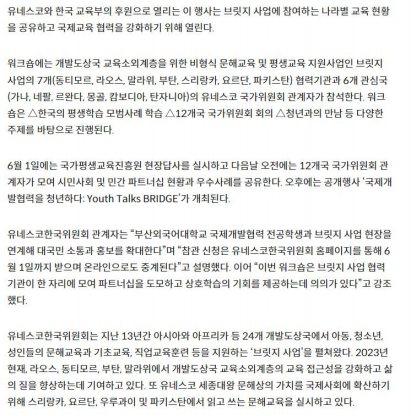
NO. Media Date 2 Maeil Business News 24 May 2023 Title Korean National Commission for UNESCO Hosts The Public Event "2023 Bridge Workshop" URL https://www.mk.co.kr/news/society/10744006 56
Korean National Commission for UNESCO Hosts Workshop for Education Cooperation with 12 Partner Countries

URL https://wwwyna co kr/view/AKR20230531101500371

NO. Media Date 3 Yonhap News Agency 31 May 2023
Title
57

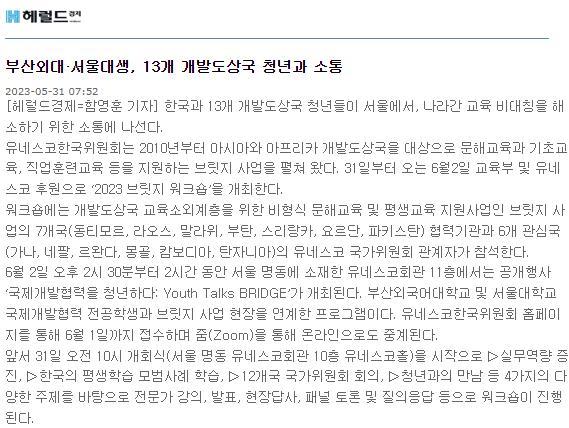
NO. Media Date 4 The Korea Herald 31 May 2023 Title Busan University of Foreign Studies and Seoul University Students Communicate with 13 Bridge Partner Countries URL http://news.heraldcorp.com/view.php?ud=20230531000072 58
Title Korean National Commission for UNESCO Hosts the 2023 Bridge Workshop
URL http://www.edupress.kr/news/articleView.html?idxno=10452
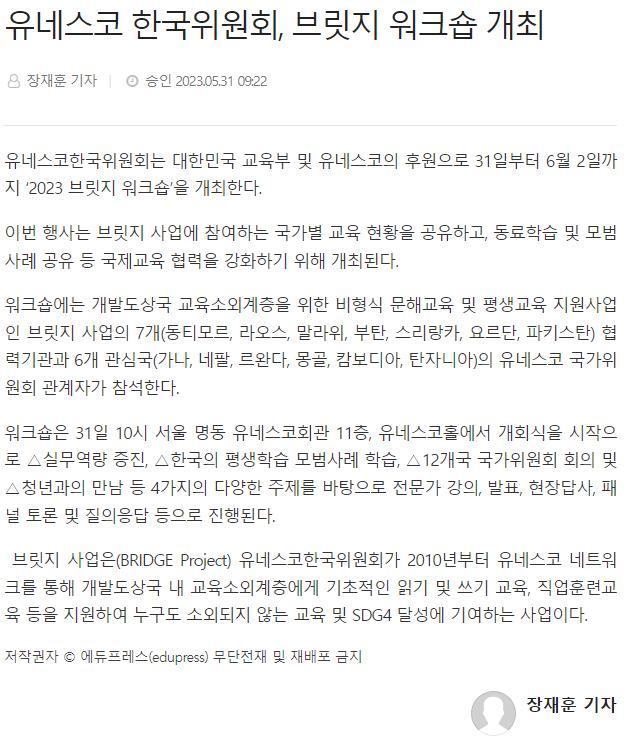
NO. Media Date 5 EduPress
31 May 2023
59
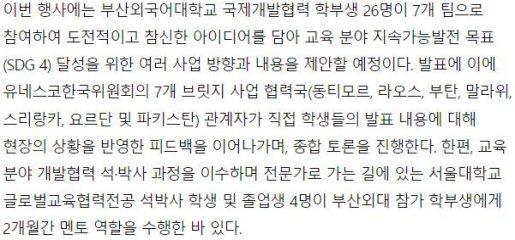
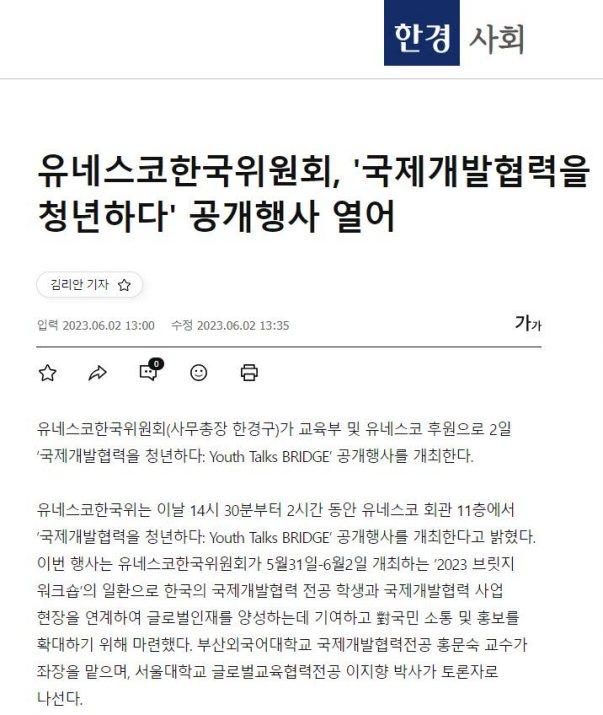
NO. Media Date 6 The Korea Economic Daily 2 June 2023 Title Korean National Commission for UNESCO Hosts a Public Event "Youth Talks BRIDGE" URL https://www.hankyung.com/society/article/202306026172i 60
2023 BRIDGE WORKSHOP AND INFORMAL MEETING OF NATIONAL COMMISSIONS HOSTED BY THE KOREAN NATIONAL COMMISSION FOR UNESCO
https://unesco.sharepoint.com/sites/natcom/en-US/news/Pages/2023-Bridge-Wor kshop-and-Informal-Meeting-of-National-Commissions-hosted-by-the-Korean-Nati onal-Commission-for-UNESCO.aspx
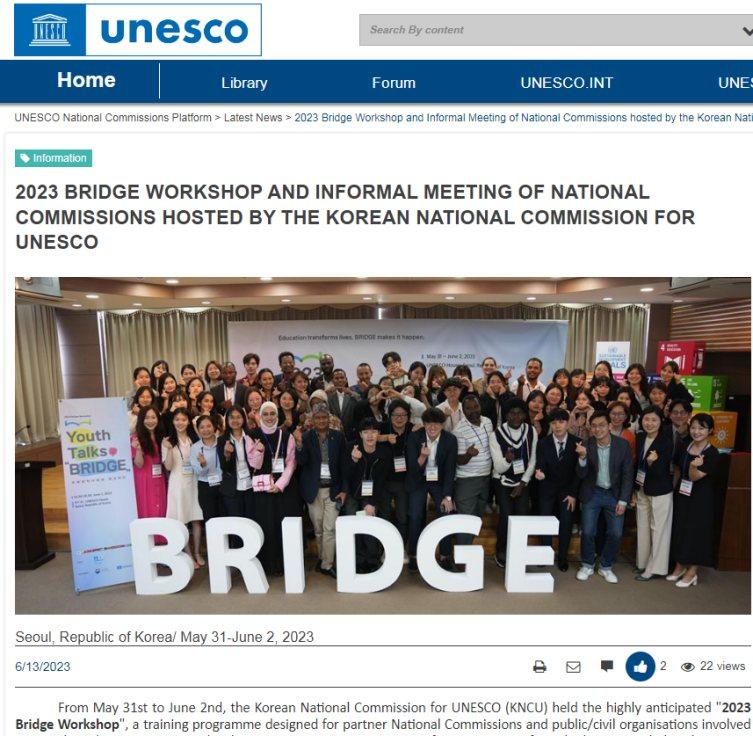
● UNESCO News Digest NO Media Date 1 UNESCO News Digest 13
Title
URL
June 2023
61

● UNESCO News (Magazine produced by the KNCU) NO Media Date 1 UNESCO News July 2023 Title
62
Education transforms life, BRIDGE family makes it happen
Annex 3 | Presentation Materials and Photos
To access presentation materials and photos from the 2023 Bridge Workshop and Informal Meeting of National Commissions for UNESCO, please scan the QR code provided below


● Presentation Materials
● Photos
63
2023 Bridge Workshop Final Report
Published in June 2023
by the Korean National Commission for UNESCO
Publisher Han, Kyung Koo, Secretary-General of the Korean National Commission for UNESCO
Editors Division of International Cooperation Programme
Address UNESCO House, 26 Myeongdong-gil, Jung-gu, Seoul, 04536, Republic of Korea
Tel +82 2 6958 4285
Email icp.division@unesco.or.kr
Website www.unesco.or.kr
© KNCU,2023Allrightsreserved
KNCU Registration No. IR-2023-RP-2
ISBN 979-11-90615-43-3 (PDF)
The authors are responsible for the choice and presentation of the facts contained in this publication and for the opinion express therein, which are not necessarily those of the Korean National Commission for UNESCO or the Ministry of Education of the Republic of Korea. No part of this publication may be reproduced or transmitted in any format or by any means without the written permission of the Korean National Commission for UNESCO.
펴낸 곳 유네스코한국위원회
펴낸 이 한경구
기획 김계신, 김바다, 김지현, 서정수, 손다희, 안가영, 이선경, 임은아, 임지우, 이지현, 장자현
주소 서울시 중구 명동길(유네스코길) 26
전화 02-6958-4285

전자우편 icp.division@unesco.or.kr
홈페이지 www.unesco.or.kr
© 유네스코한국위원회,2023
유네스코한국위원회 간행물등록번호 IR-2023-DI-2
ISBN 979-11-90615-43-3 (PDF)
동 출판물에 기재된 구체적인 내용과 방향은 유네스코한국위원회의 입장과 반드시 일치하지 않을 수도 있습니다
이 책은 저작권법에 따라 보호받는 저작물이므로 무단전재와 무단복제를 금하며, 이 책 내용의 전부 또는 일부를 이용하고자 할 경우에는 유네스코한국위원회로 문의해주시기 바랍니다
64

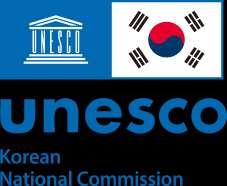











 Ms.SunKyungLee,DirectoroftheDivisionofInternationalCooperationProgrammedelivering herpresentation
Ms.SunKyungLee,DirectoroftheDivisionofInternationalCooperationProgrammedelivering herpresentation


 Ms RinzinWangmodeliveringherpresentation
Ms RinzinWangmodeliveringherpresentation

 Ms LinaAlmutazQtaishatpresentingbestpracticesfromtheBridgeSejongJordanProject
Ms LinaAlmutazQtaishatpresentingbestpracticesfromtheBridgeSejongJordanProject
 Mr ChifuniroClementChikotipresentingbestpracticesfromtheBridgeMalawiProject
Mr ChifuniroClementChikotipresentingbestpracticesfromtheBridgeMalawiProject







































 TheLaosteamconsistingofthreestudents (NanshanswutKim,JiyunKim,andHansol Park)presentingtheirprojectontheBridgeLaos Project
TheJordanteamconsistingofthreestudents (SoyoonEom,YoonaKim,andSoohyeonLee) presentingtheirprojectontheBridgeSejong JordanProject
TheLaosteamconsistingofthreestudents (NanshanswutKim,JiyunKim,andHansol Park)presentingtheirprojectontheBridgeLaos Project
TheJordanteamconsistingofthreestudents (SoyoonEom,YoonaKim,andSoohyeonLee) presentingtheirprojectontheBridgeSejong JordanProject

































